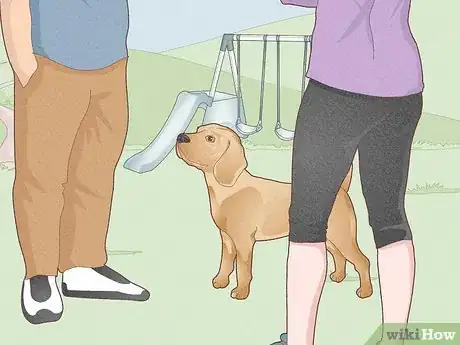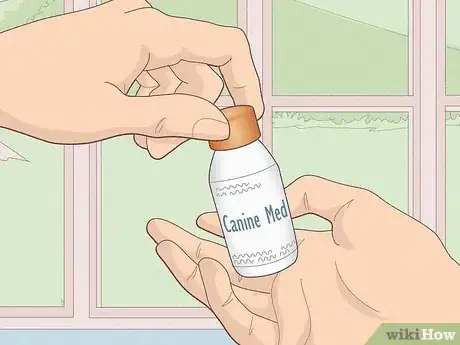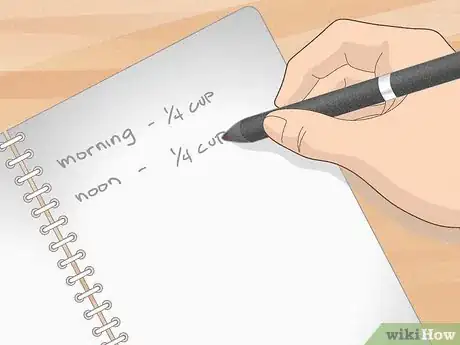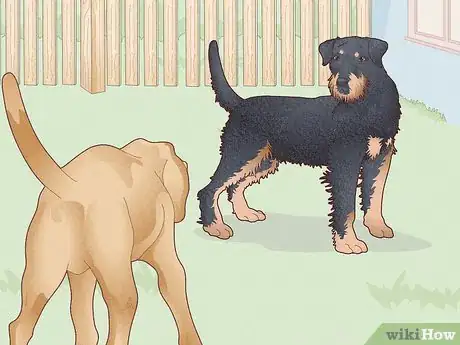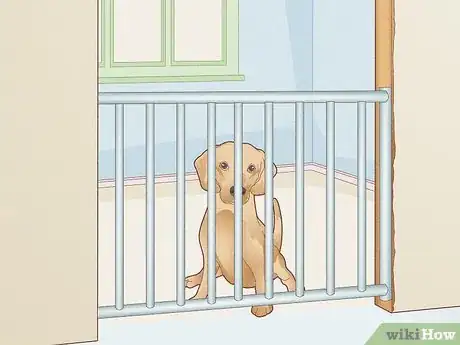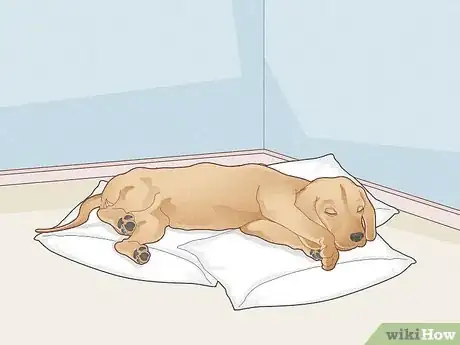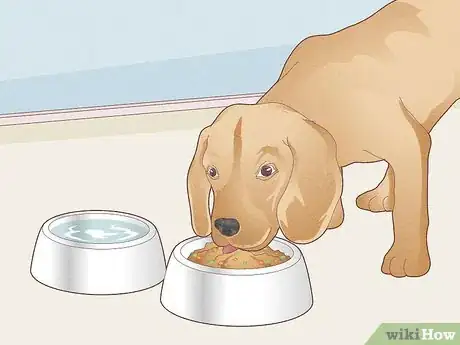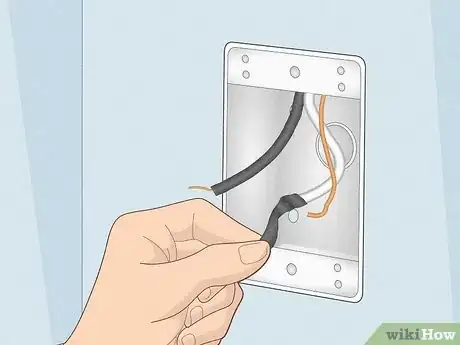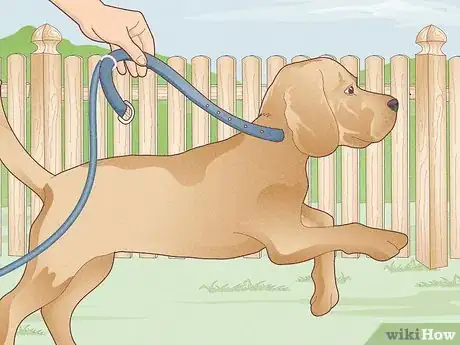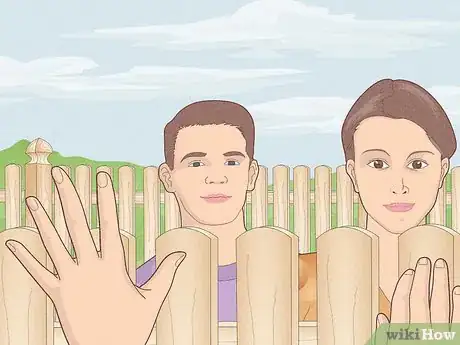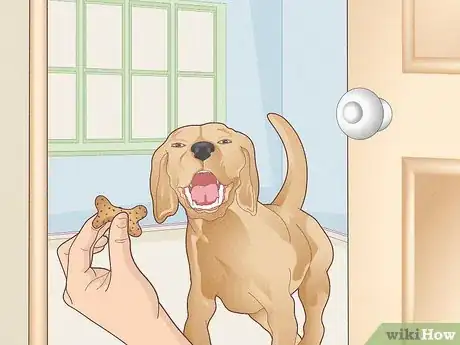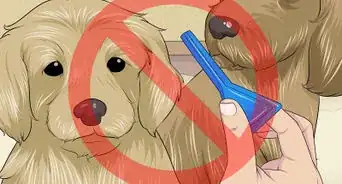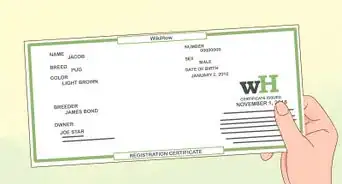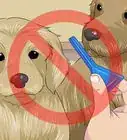This article was co-authored by Elisabeth Weiss. Elisabeth Weiss is a Professional Dog Trainer and owner of Dog Relations NYC, a dog training service in New York, New York. Elisabeth relies on science-based, force-free, and reward-based techniques. Elisabeth offers behavior training, puppy manners, body awareness and injury prevention, diet, exercise and dog nutrition services. Her work has been featured in New York Magazine and on the Dog Save the People podcast. She also trained all the dogs in the movie "Heart of a Dog" by Laurie Anderson that features Elisabeth's journey with Laurie Anderson's and Lou Reed's dog Lolabelle and how her passion for playing the keyboards played a significant role in improving her quality of life after being diagnosed with pancreatic cancer.
This article has been viewed 48,901 times.
When a friend asks you to take care of their dog, it is just as important as taking care of your own pet. Your friend is trusting you to take good care of their beloved pet, so make sure you feel prepared to do so before the owner leaves. By doing a little prep beforehand and following the owner’s instructions closely, your pet sitting experience is bound to be a good one.
Steps
Learning About the Dog
-
1Meet and spend time with the dog in advance if possible. This is especially important if you’ve never actually met or become acquainted with the dog you’ll be caring for. You want to make sure you’re comfortable with the dog, and that the dog is also comfortable around you.[1] Try meeting up with your friend and the dog on neutral ground, like at a park. Spend a little while getting to know the dog. You can also use this time to make sure you're fit to it's energy level. Try playing fetch with it, or do tricks to get acquainted. Even if you're okay with the dog make sure it is comfy with you.
- If you’ve already met the dog you’ll be caring for, still try to spend a little bit of time with the dog before it’s in your care to renew your bond.
-
2Ask about any medications the dog is on. Before the dog is left in your care, talk to its owner about what medications it’s on. Whether it’s medicine they have to take daily, or something they’ll need to take just once while they’re with you, make sure you have all the instructions for each medication before the owner leaves. It’s a good idea to have the owner write down these instructions, or for you to take notes yourself as they explain.
- Leave the instructions with the bottles of medication in a place where you can see it, but that is out of reach of the dog and/or any children in the house.
- Having the number for the dog’s veterinarian is important, even if they aren’t on any medications. You’ll want someone to reach out to if anything goes wrong. Their vet will have all the dog’s records, so they can provide the best care in an emergency. They can also advise you on any medications if you lose the instructions, or aren’t sure about anything.
Advertisement -
3Write down feeding instructions. Many dogs are on very specific diets. Make sure you know how much to feed the dog as well as when to feed them. Ask the owner if the dog likes to “graze,” or eat a little bit now and then throughout the day. This would mean leaving his food down all day, so if you have a pet of your own that might eat the food, make sure you work this out. Ask about any foods the dog isn’t allowed to have, and how many treats they’re allowed on a daily basis.
- Keep in mind that some dogs might be a little stressed out when their owner goes away, so their eating habits might change a bit until they adjust.
-
4Ask about any behavioral issues. Before you are left alone with the dog, make sure you’re aware of any possible aggression issues, housebreaking problems, or even shyness the dog might be dealing with. Some dogs might have leash aggression, or they might be very timid around new people. Some dogs might occasionally still have accidents in the house. Make sure you’re prepared for these potential problems, and talk with the dog’s owner about ways to deal with them successfully.
- If the dog has serious aggression issues, you might suggest that the owner board them with a professional boarding facility that is better equipped to handle that sort of behavior, or if the dog is shy, you may want to give a space of its own to get comfy. Give it its favorite toys, and give it its time to adjust.
Caring For a Friend’s Dog in Your Home
-
1Let the dog meet your pets, if you have any. If the dog will be staying at your home and you have pets in the house, make time to introduce the dog to your pets prior to the dog’s stay with you. Introduce your friend’s dog to your dog somewhere neutral first, like a park. Then, you can bring the dog to your home after they’ve been acquainted. Make sure they get along with any other pets in the house, like cats. If there are any issues, you’ll have time to sort them out before the owner leaves.[2]
- Consider keeping the dog separate from your pets when you are not home. Since they are still new to one another, there might be a chance for one to become territorial over toys or aggressive when you aren’t there to intervene.
-
2Use baby gates to keep the dog in one area of the house. Even if the dog sleeps in a crate at night, or stays in one while home alone, you really shouldn’t keep the dog in its crate just as a means of keeping it in one place. It’s a good idea to put up baby gates to confine the dog to a “safe” area of the house, or even to keep the dog separate from your pets while you aren’t around.[3]
- If you plan to confine the dog to a certain part of your home, make sure that the dog still has access to water.
-
3Set up an area for the dog to sleep. Ask the owner how the dog usually sleeps at night in its own home. Does the dog sleep in bed with the owner? Does the dog sleep in a crate? Does the dog have its own bed? However the dog sleeps, set up a similar sleeping situation for it in your home. If the dog has its own bed, for example, bring that bed over to your house so it will have a familiar place to lie down and rest at night. If he sleeps in a crate, bring the crate to your house.
- Having something from the dog’s own home can be helpful. The item will smell like home, and it might act as a comfort for the dog. So, even if the dog sleeps in a crate, make sure to bring a blanket or pillow from its home to put in the crate with him.
- If the dog usually sleeps in bed with its owner, but you aren’t comfortable with the dog sleeping in your bed, find some middle ground. For example, you could set up the dog’s own bed right beside yours on the floor.
-
4Put bowls down for food and water. If you can, just use the dog’s regular bowls from its home. Make sure you know whether or not to leave food down all day for the dog, and make sure your own pets won’t eat the dog’s food. Make sure the dog always has access to fresh water. Change the water in the water bowl a few times a day to make sure it stays clean and fresh.
- To deter your own pets from eating the dog’s food, try feeding them in separate rooms, or keeping them separated when you aren’t around if the dog needs food down all the time.
- Consider putting down a mat or towel under the bowls. This will keep water from sloshing onto the floor, and help keep the dog’s food bowl in place while he eats.
-
5Make your house safe for the dog. To ensure the safety of the dog, make sure to put all fragile and/or toxic or harmful items out of reach. Put up loose cords, remove items from the coffee table, put away the trash can or make sure the lid is securely shut, keep all food put away and out of reach, and keep toilet lids shut. This will help keep the dog out of trouble, as it might be a little more curious than usual being in a new environment.
- Ask the owner if the dog has any chewing habits. If so, make sure to put shoes away in the closet and shut the door securely.
Caring For a Friend’s Dog in Their Home
-
1Decide if you will stay at your friend’s home. Depending on the length of time you’ll be caring for the dog, you might consider simply staying at your friend’s home for your own convenience. Or, if you will just be caring for the dog a short time, simply checking in a few times a day might suffice. Either way, you will want to discuss this with your friend beforehand.
- How often you check in might depend on the dog’s needs and activity level. For example, an older, more mellow dog might only need one or two short walks a day, while a younger, more active dog might require more frequent attention and checking on.
-
2Follow the normal house rules. Ask the owner what the normal routine is for the dog. Is the dog allowed on the furniture? Does the dog get one or two walks per day? Is the dog allowed in the backyard without a leash? Should you leave the dog’s food down all day? Whatever the normal rules and routines of the house are, try to stick to them as best you can. That way, the dog will feel more relaxed and won’t develop any bad habits while the owner is away.[4]
- If the dog is usually left alone during certain hours of the day, it might be a good idea to let him be during that time. Since it’s part of his routine, it will be easier for him to get back to normal when his owner returns.
- If the dog has a certain walk routine—like walks at certain times of the day—try sticking to that schedule. This will help keep the dog in its usual routine, even while its owner is away.
-
3Meet the neighbors. If you’ll be going in and out of a friend’s home while they are out of town, make sure the neighbors know you’re allowed to be doing so. You don’t want to end up with police knocking on the door because a neighbor saw a strange person! Before the owner leaves, be sure to have them introduce you to the neighbors and let the neighbors know that you’ll be dogsitting.[5]
- The neighbors might also be able to pop in and let the dog out if you have an emergency, so ask the owner to leave a key with a neighbor they trust, and get that neighbor’s contact information.
-
4Greet the dog with a treat when you enter the home. Once the owner leaves, the dog might be surprised to see someone unfamiliar entering the home. Keep a little bag of treats in your car or bag, and offer the dog one when you enter the door. Make sure you use a type of treat that the dog usually gets—try grabbing a handful of the treats their owner already has. This will help the dog relax and trust you when you first enter.[6]
- You might not have to do this every time you enter. Just do it the first few times until the dog is used to you coming in, instead of its owner.[7]
- When first greeting the dog, consider dropping the treats down onto the floor instead of feeding the dog directly from your hand. This can help give the dog a chance to get used to your presence at a gradual pace.[8]
Expert Q&A
Did you know you can get expert answers for this article?
Unlock expert answers by supporting wikiHow
-
QuestionHow do you comfort a dog that misses their owner?
 Elisabeth WeissElisabeth Weiss is a Professional Dog Trainer and owner of Dog Relations NYC, a dog training service in New York, New York. Elisabeth relies on science-based, force-free, and reward-based techniques. Elisabeth offers behavior training, puppy manners, body awareness and injury prevention, diet, exercise and dog nutrition services. Her work has been featured in New York Magazine and on the Dog Save the People podcast. She also trained all the dogs in the movie "Heart of a Dog" by Laurie Anderson that features Elisabeth's journey with Laurie Anderson's and Lou Reed's dog Lolabelle and how her passion for playing the keyboards played a significant role in improving her quality of life after being diagnosed with pancreatic cancer.
Elisabeth WeissElisabeth Weiss is a Professional Dog Trainer and owner of Dog Relations NYC, a dog training service in New York, New York. Elisabeth relies on science-based, force-free, and reward-based techniques. Elisabeth offers behavior training, puppy manners, body awareness and injury prevention, diet, exercise and dog nutrition services. Her work has been featured in New York Magazine and on the Dog Save the People podcast. She also trained all the dogs in the movie "Heart of a Dog" by Laurie Anderson that features Elisabeth's journey with Laurie Anderson's and Lou Reed's dog Lolabelle and how her passion for playing the keyboards played a significant role in improving her quality of life after being diagnosed with pancreatic cancer.
Professional Dog Trainer One of the most important things is to wait for the dog to come to you. Try to avoid immediately handling the dog or staring at them. Let the dog come to you and give it time. I would recommend throwing treats on the floor initially rather than trying to feed the dog with your hands. This usually helps a dog get comfortable.
One of the most important things is to wait for the dog to come to you. Try to avoid immediately handling the dog or staring at them. Let the dog come to you and give it time. I would recommend throwing treats on the floor initially rather than trying to feed the dog with your hands. This usually helps a dog get comfortable. -
QuestionWhat if I'm scared of dogs but don't want to let down my friend?
 Community AnswerYou probably shouldn't look after your friend's dog if you're scared of them. The dog will sense your fear and it will get anxious as well, it wouldn't be good for either one of you. Just tell your friend you're scared of dogs, I'm sure he/she will understand.
Community AnswerYou probably shouldn't look after your friend's dog if you're scared of them. The dog will sense your fear and it will get anxious as well, it wouldn't be good for either one of you. Just tell your friend you're scared of dogs, I'm sure he/she will understand.
Warnings
- Have the number to the closest after-hours emergency vet handy in case you need it.⧼thumbs_response⧽
References
- ↑ Elisabeth Weiss. Professional Dog Trainer. Expert Interview. 3 September 2020.
- ↑ https://www.animalhumanesociety.org/training/introducing-new-dog-resident-dog
- ↑ http://www.peta.org/living/companion-animals/crate-free-dog-checklist/
- ↑ Elisabeth Weiss. Professional Dog Trainer. Expert Interview. 3 September 2020.
- ↑ http://articles.chicagotribune.com/2013-05-16/features/sc-fam-0514-pet-sitting-etiquette-20130514_1_pet-owners-pet-food-other-pets
- ↑ https://www.cuteness.com/blog/content/dog-sitting-tips
- ↑ Elisabeth Weiss. Professional Dog Trainer. Expert Interview. 3 September 2020.
- ↑ Elisabeth Weiss. Professional Dog Trainer. Expert Interview. 3 September 2020.
About This Article
To care for a friend's dog at your house, make sure you have enough time and space in your home, depending on the dog's size and activity level. You should also meet the dog ahead of time to learn about its feeding schedule, any medications it may be on, and if there are any behavioral issues that you should be aware of. Additionally, if you have dogs, make sure to introduce them ahead of time somewhere neutral, like the dog park, to avoid territorial aggression. Once you're home, use baby gates to keep the dog in one area. For more tips from our Veterinary co-author, including how to care for a friend’s dog in their house, keep reading!
